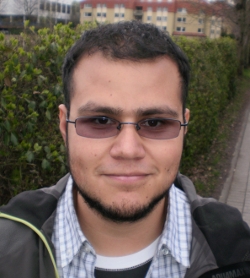| Dr. Miguel Martinez-Dorantes | |||||||||
|
Publications(up to 2018)
-
Strong Purcell effect on a neutral atom trapped in an open fiber cavity, Phys. Rev. Lett. 121, 17360 (2018)arXivBibTeX ABSTRACT »
ABSTRACT »We observe a sixfold Purcell broadening of the D2 line of an optically trapped 87Rb atom strongly coupled to a fiber cavity. Under external illumination by a near-resonant laser, up to 90% of the atom's fluorescence is emitted into the resonant cavity mode. The sub-Poissonian statistics of the cavity output and the Purcell enhancement of the atomic decay rate are confirmed by the observation of a strongly narrowed antibunching dip in the photon autocorrelation function. The photon leakage through the higher-transmission mirror of the single-sided resonator is the dominant contribution to the field decay (κ≈2π×50 MHz), thus offering a high-bandwidth, fiber-coupled channel for photonic interfaces such as quantum memories and single-photon sources.
-
State-dependent fluorescence of neutral atoms in optical potentials, Phys. Rev. A 97, 023410 (2018)arXivBibTeX ABSTRACT »
ABSTRACT »Recently we have demonstrated scalable, nondestructive, and high-fidelity detection of the internal state of 87Rb neutral atoms in optical dipole traps using state-dependent fluorescence imaging [M. Martinez-Dorantes, W. Alt, J. Gallego, S. Ghosh, L. Ratschbacher, Y. Völzke, and D. Meschede, Phys. Rev. Lett. 119, 180503 (2017)]. In this paper we provide experimental procedures and interpretations to overcome the detrimental effects of heating-induced trap losses and state leakage. We present models for the dynamics of optically trapped atoms during state-dependent fluorescence imaging and verify our results by comparing Monte Carlo simulations with experimental data. Our systematic study of dipole force fluctuations heating in optical traps during near-resonant illumination shows that off-resonant light is preferable for state detection in tightly confining optical potentials.
-
Fast Nondestructive Parallel Readout of Neutral Atom Registers in Optical Potentials, Phys. Rev. Lett. 119, 180503 (2017)arXivBibTeX ABSTRACT »
ABSTRACT »We demonstrate the parallel and nondestructive readout of the hyperfine state for optically trapped 87Rb atoms. The scheme is based on state-selective fluorescence imaging and achieves detection fidelities > 98% within 10 ms, while keeping 99% of the atoms trapped. For the readout of dense arrays of neutral atoms in optical lattices, where the fluorescence images of neighboring atoms overlap, we apply a novel image analysis technique using Bayesian inference to determine the internal state of multiple atoms. Our method is scalable to large neutral atom registers relevant for future quantum information processing tasks requiring fast and nondestructive readout and can also be used for the simultaneous readout of quantum information stored in internal qubit states and in the atoms’ positions.
-
High Finesse Fiber Fabry-Perot Cavities: Stabilization and Mode Matching Analysis, Appl. Phys. B 122, 47 (2016)arXivBibTeX ABSTRACT »
ABSTRACT »Fiber Fabry-Perot cavities, formed by micro-machined mirrors on the end-facets of optical fibers, are used in an increasing number of technical and scientific applications, where they typically require precise stabilization of their optical resonances. Here, we study two different approaches to construct fiber Fabry-Perot resonators and stabilize their length for experiments in cavity quantum electrodynamics with neutral atoms. A piezo-mechanically actuated cavity with feedback based on the Pound-Drever-Hall locking technique is compared to a novel rigid cavity design that makes use of the high passive stability of a monolithic cavity spacer and employs thermal self-locking and external temperature tuning. Furthermore, we present a general analysis of the mode matching problem in fiber Fabry-Perot cavities, which explains the asymmetry in their reflective line shapes and has important implications for the optimal alignment of the fiber resonators. Finally, we discuss the issue of fiber-generated background photons. We expect that our results contribute towards the integration of high-finesse fiber Fabry-Perot cavities into compact and robust quantum-enabled devices in the future.
-
Electromagnetically-induced-transparency control of single-atom motion in an optical cavity, Phys. Rev. A 89, 033404 (2014)arXivBibTeX ABSTRACT »
ABSTRACT »We demonstrate cooling of the motion of a single neutral atom confined by a dipole trap inside a high-finesse optical resonator. Cooling of the vibrational motion results from electromagnetically induced transparency (EIT)–like interference in an atomic lambda-type configuration, where one transition is strongly coupled to the cavity mode and the other is driven by an external control laser. Good qualitative agreement with the theoretical predictions is found for the explored parameter ranges. Further, we demonstrate EIT cooling of atoms in the dipole trap in free space, reaching the ground state of axial motion. By means of a direct comparison with the cooling inside the resonator, the role of the cavity becomes evident by an additional cooling resonance. These results pave the way towards a controlled interaction among atomic, photonic, and mechanical degrees of freedom.
-
Bayesian Feedback Control of a Two-Atom Spin-State in an Atom-Cavity System, Phys. Rev. Lett. 109, 173601 (2012)arXivBibTeX ABSTRACT »
ABSTRACT »We experimentally demonstrate real-time feedback control of the joint spin-state of two neutral Caesium atoms inside a high finesse optical cavity. The quantum states are discriminated by their different cavity transmission levels. A Bayesian update formalism is used to estimate state occupation probabilities as well as transition rates. We stabilize the balanced two-atom mixed state, which is deterministically inaccessible, via feedback control and find very good agreement with Monte-Carlo simulations. On average, the feedback loops achieves near optimal conditions by steering the system to the target state marginally exceeding the time to retrieve information about its state.
Forschungsgebiete
Unsere Gruppe
Veröffentlichungen
Abgeschlossene Projekte
Lehre
Weitere Informationen
Anmeldung
Vorträge
- Curtius Lectures
- 03/05/22 - 06/05/22










